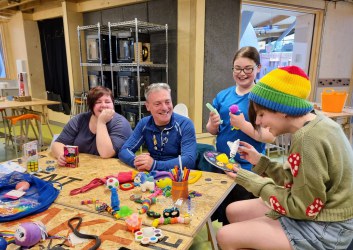During the Community voice, improving accessibility for all session at the 2023 Ecsite Conference, David Jones from Life Science Centre in Newcastle, UK, spoke about creating sensory bags for use in interactive science centres. He received great interest during and many more inquiries after the Conference and kindly reached out to see if we could share the key learnings from his team with the Ecsite audience. Of course, we didn’t hesitate to help spread the word.
Life have continuously been learning over the last 5 years and expect to keep learning.
ABOUT LIFE SCIENCE CENTRE
The team at Life is committed to breaking down barriers to ensure that the joy of scientific discovery is accessible to all, by creating a more inclusive and enriching experience for visitors. Life has won a series of awards recognising their innovative work in this area, including the 2022 Mariano Gago Ecsite Award.
WHY SENSORY BAGS?
Sensory bags are beneficial for all ages. They help reduce sensory overload and increase engagement in neurodivergent individuals. Whilst Life is a Science Centre, the sensory bags can be used on many situations and different institutions.
Read the full article with pictures here
Watch David's video describing Sensory Bags here
THE LIFE SCIENCE CENTRE TEAMS’ 10 TOP TIPS:
1. Reach out & engage: Before you start, reach out to your local neurodivergent communities. Listen, and act on their feedback. When communities feel heard, you become a trusted partner, which leads to improved accessibility for everyone.
2. Keep the bags unbranded and not too big: When discussing with and learning from the autistic community, David discovered that they didn’t want to be identified as carrying a sensory bag in the centre. Keep the bags compact and without branding so that everyone feels comfortable and confident!
3. Provide different options: 8-10 fidgets seem to be the right amount. Different people like different fidgets, so ask your community to show you which ones they prefer, and why, and use the resources you have readily available in your country.
4. Identify what’s in the bag: Take a photo of each fidget in your bag, make one A4 with a picture of each and the name to keep in the bag. It’s handy for stocktake but also great for parents to know the names if they decide to buy the fidget their child really liked. These A4 documents are best laminated for longevity.
5. Add a pair of ear defenders: Ear defenders reduce, but do not remove all, environmental noise. Try them yourself to better understand the benefits, it’s a real game changer.
6. Create a visual story: Help your visitors prepare for their visit by providing a detailed description of the institution, displaying it on your website and putting a copy inside the bag. Tip: Use clear laminated folders to keep them neat and ensure people see them in the bag. Check out what Life has done!
7. Add them to labs or rooms for schools: Add a box of fidgets to your school rooms and let the teachers and students know they are available.
8. Tell people about the availability of the bags: You can have the best bags in the world but if people don’t know they are there, it won’t help them. Communicate on your website and onsite and don’t forget to let your communities know. Life hire out their bags for a fully refundable deposit and communicate them online and with a clear sign at reception.
9. Keep listening & learning: Get your team on board early and listen to feedback and visitors, keep learning and trying new things and support your team with ongoing training sessions.
10. Share your learnings:The process of developing a Sensory Bag creates a rich opportunity to learn about and support our neurodivergent communities. We hope you will share pictures and learnings from your experiences with us either by email to nhamilton@ecsite.eu or on socials.
Can't wait for our next piece on accessibility and inclusivity Tips? Why not check out our last article in conversation with Esplora Interactive Science Centre on Top Tips - Hidden Disabilities Sunflower, if you haven't already.

